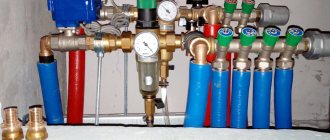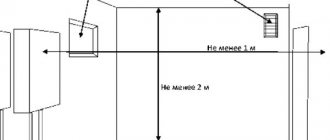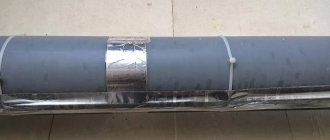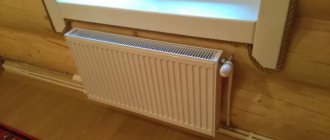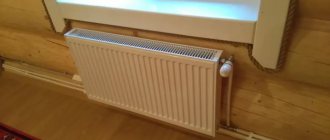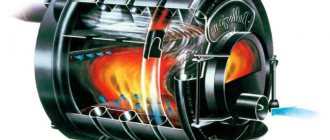Although the collector principle of organizing heating and water supply systems has not yet become widespread in our country, more and more people are showing keen interest in it.
What is a water supply manifold?
Let's consider the design features of the system and installation rules.
Application area
Stabilizes pressure and evenly distributes water to all points of consumption.
The purpose of the collector is to equalize pressure in the water main, preventing sudden changes in pressure and water hammer.
With his help:
- Autonomous systems are being created that supply water to each apartment in a multi-story building.
- Water pipes are connected to each plumbing fixture.
- All plumbing fixtures function independently of each other.
To achieve a better result, it is recommended to install collector devices on cold and hot water supply. The outlet of each pipe section is equipped with a tap or valve that allows you to quickly shut off the flow of water to any point. This will help avoid leaks if malfunctions occur. The collector is placed on the main riser and is usually hidden in a plumbing closet. It is not advisable to cover it with furniture or sew it into a wall without easy access.
feel the difference
First, we will give clear and precise definitions of the main types of wiring.
- Tee (series) circuit. All plumbing fixtures are connected to one pipe through tees. At the same time, nothing prevents you from installing shut-off valves in front of each of them.
Traditional series wiring looks like this
- Collector. Shut-off valves are concentrated on entry into an apartment, house or any other place. The key difference is that all the valves are located next to each other and from them to each device, be it a toilet, faucet or radiator, there is an independent pipe or pair of pipes.
And this is her antagonist
- Mixed. A mix of both options. Let's say that a washbasin and shower located in different directions have a manifold and independent pipelines, and a toilet, bidet and washing machine located near the riser have a common tee.
Design and principle of operation
Redistribution of the water jet by the collector into several directions with the same pressure is the main function of the installation.
The switchgear is connected directly to the riser. There is a threaded connection on both sides (internal thread on one, external thread on the other) for connection to the main pipe and additional manifolds.
The inlet hole is 20-40 percent larger in size than the outlet holes. For a collector water supply system in a standard apartment, the first section is 3/4 inch, the second - 1/2 inch.
Shut-off elements at the outlet allow you to shut off the water flow in a timely manner and adjust the power for each individual point to stabilize pressure or save on water.
Adviсe
The collector is needed in apartments and private houses, public, medical and educational institutions, and retail facilities. In a word, it is useful wherever there is a water supply system and there are several water consumers. The collector performs an important function and is one of the most important elements in the water supply system. Therefore, the choice of this element must be approached consciously and competently. It is advisable to use a number of recommendations:
- For hot and cold water, two corresponding models are selected, which are marked differently in blue and red.
- Choosing a high-quality collector from a trusted manufacturer will ensure stable operation of the system.
- Proper installation and adherence to technology will minimize the likelihood of leakage and allow you to enjoy stable operation of the system.
- A manifold with locking mechanisms on each outlet is convenient, especially when one of the elements needs repair.
- The manifold material must be selected in accordance with the pipes used during the installation of the system.
- The number of outlets must correspond to the number of water consumers or groups created from several consumers.
- It is better to buy a manifold, fittings and all other additional elements (FUM, gaskets, adapters and pipes) from one company. In this case, all elements will fit together. Otherwise, there may be discrepancies in dimensions, and parts will have to be replaced.
- To make changes to the system, it is necessary to leave free outlets in the comb, which will be closed with plugs. In this case, there is no need to change the collector or add an additional comb to it.
- It is better to choose a manifold with valves. In this case, there is no need to perform separate installation for each of them. Choosing such a collector will reduce the time and volume of installation work, and minimize the likelihood of leaks at the connection points.
See the following video for assembling the water supply collector.
Reservoir classification
Devices are made from different materials:
- brass;
- polypropylene;
- made of cross-linked polyethylene;
- made of stainless steel.
Stainless steel
Polypropylene
Brass
Devices are classified according to the method of connecting pipes. Threaded fastening implies the presence of internal or external threads. The connection is made using a Eurocone or using compression fittings for pipes made of metal-plastic and plastic.
For water supply pipes made of polypropylene, plastic shaped elements for soldering are also used. But cross-linked polyethylene products cannot be connected this way; compression fittings are required.
The collector installation has a different number of outlets: from 2 to 6. The products are equipped with two fasteners corresponding to the cross-section of the main pipe. With their help, several blocks are combined into one device without the use of additional transition parts. Increasing the length of the comb is necessary in cottages with a large number of plumbing fixtures.
It happens that only one device is installed. Then special plugs are used to close unused outputs.
The devices block flows to some consumers, while others continue to work. This helps when repairing or replacing plumbing, restoring a damaged area, or cleaning a water supply.
Types of distribution combs
Collectors are mounted on hot and cold water supply. For convenience and to prevent confusion, manufacturers produce models in different colors (red and blue).
By type, combs differ in the number of taps, which varies from 2 to 4. For a larger number of connections, it is recommended to use combinations of several distribution devices. For example, the existing 6 points can be equipped with two combs for 3 outputs.
Read also: Why is the Scroll Lock key needed?
Equipping the heating system with a manifold will be no less useful. Heating will be carried out evenly, which will eliminate differences in the temperature of individual rooms.
The operation of any type of switchgear is safe. The absence of pressure drop will eliminate emergency situations with breakthroughs and flooding.
Criterias of choice
Distribution manifold for hot and cold water
Before choosing a device, it is important to calculate the total number of water consumers. These include toilets, taps, dishwashers, washing machines and other appliances. Their number must match the number of outputs. If you plan to connect additional plumbing fixtures in the future, you should choose a comb with a large number of pins. Unused exits are blocked with special plumbing plugs.
The type of device varies depending on the material and cross-section of pipe sections and fittings. To make it easier to install the collector, select a water comb with already installed taps.
If the number of points is greater than the number of pins, install several devices, connecting them into one.
It is worth familiarizing yourself with the technical characteristics of various combs to make a choice:
- pressure in the water supply line;
- device throughput;
- installation for hot or cold water supply;
- Possibility of connecting additional plumbing fixtures.
Situations arise when a flexible water hose is required for connection, which is determined by the location of the device and the area of the room. Hoses are easy to install, but they are less reliable in terms of leaks.
Features of the design of water supply in home heating
If the heating system is made according to a combined scheme, then the radiators work in tandem with the pipeline of the “warm floor” system, and the water supply collector is equipped with a mixing unit so that when the liquid in the heated floor circuit cools, water from the collector is added to this circuit by mixing.
When purchasing a ready-made manifold, it is recommended to pay attention to the distances between the outlets of the supply and return manifolds, since in Asian devices these values may not correspond to European standards, and the water mixing unit may simply not fit.
Manifold for water heated floor
The manifold for “warm floors” has outlet pipes Ø 16 mm, 18 mm and 20 mm. For highways laid in country houses, it is recommended to install pipes with Ø ≤ 16 mm. If there are several “warm floor” circuits in the house, and they have different lengths, then the collector needs a balancing system with a flow meter, since without a balancer, the floor with a shorter pipe route will always be hotter.
By rotating the ring on the flow meter, its throughput capacity is changed, and therefore the temperature in the circuit is regulated. The hot water consumption is visually controlled through a special slot with a scale.
Rules for installing water supply systems
For the water supply main, collectors are also installed in two units: one collector is for hot water supply, the other is for cold water supply. When implementing such a solution, no control valves will be needed - only shut-off valves or taps are installed. Such taps in the cold water supply line are equipped with blue handles, for hot water supply - with red handles. The main water supply manifold pipe is installed in a dry place, but the ideal solution would be to install a separate cabinet for the manifold. For this purpose, factory units are equipped with special fasteners, and there are places for them in factory cabinets. When making a collector with your own hands, the method and scheme of placement and fastening of the collector will need to be thought out separately - choose any option that ensures the conditions described above.
Installation rules
Collector water supply scheme
You can do the wiring of the water supply network with the installation of the collector yourself. It is assembled according to this scheme: the main pipe is connected to the comb directly, without any branches. Pipes supplying water to each plumbing fixture are connected to it. The devices are conveniently installed behind the toilet flush cistern. But other versions are also acceptable.
To choose a location for the comb, take into account:
- accessibility for repair and installation;
- humidity (moderate);
- the presence of a load-bearing wall on which the device is fixed;
- the ability to work in case of an accident at any time of the day thanks to additional lighting.
Sometimes the device is installed in a separate room or closet. To secure the collector, special clamps are used.
Combs are installed for both hot and cold water supply. For ease of use and to avoid confusion, manufacturers produce collectors in two shades: red and blue.
The installation should be carried out only after the wiring has been installed, meters, check valves, filters and other parts of the water line have been installed. At the connection point to the main riser, the system is equipped with ball valves that shut off the main flow. There is also a coarse filter and a meter that allows you to control water consumption.
It will be necessary to complete the installation of water lines for each point of consumption. To do this, it is worth leaving free outlets in the collector, plugging them with plumbing plugs. Only after this can the unit responsible for distribution be installed. Install it without additional sealing.
Carrying out installation in this order will reduce the load on the connections and help avoid their deformation. This is especially true for non-professionals.
When installing, you need to take into account the following points:
- The device responsible for distribution is certainly equipped with shut-off elements for adjusting and shutting off the flow.
- The cross-section of the connection point to the main line must be larger than the standard 15 mm. This diameter of the inlet pipe makes it possible to provide the consumer with the required amount of water while simultaneously using several plumbing fixtures.
- To neutralize water hammer, which can cause serious damage to the water supply, you need to install a special damper.
- Adapter fittings are installed on the threaded connection of the valves or the outlets from the manifold. Pipes supplying water to points of consumption are connected to them.
- When equipping a building with two or more floors with water supply, it may be necessary to install a circulation pump.
If a hidden water distribution system scheme is chosen, you will need to install thermal insulation material on the supply pipes. This method allows you to avoid cracking of the screed or the places where the grooves are sealed. Heat loss in the hot water supply pipeline will also be reduced.
Main manufacturers
Some people pay little attention to this aspect. Confident that the design is simple, they do not think about the fact that over time, water supply collectors fail. Each of them will need repair or replacement. The only question is how soon this will happen, and how often problems will arise. Now there are several “whales” on the plumbing market:
Despite the fact that the products of this company can be classified as a budget segment, the quality is very acceptable. The products are reliable, easy to use, unpretentious, and durable.
The price of this product is higher, but the consistent German quality allows you to use the products of this company for a long time. The brass from which the structural elements are made can withstand aggressive environments, does not rust or rot.
- Tiemme (Italy).
The products belong to the middle price segment, which has made them popular among professionals, developers, and contractors. Low cost combined with reliability are the main characteristics of collectors of this brand.
The main advantage is the use of innovative technologies in production. Each product is tested for functionality before leaving the assembly line. Material: brass.
The company produces a full range of components with which you can install a supply or heating system. The range is constantly expanding, and now there are more than 1000 items.
Advantages and disadvantages
The device allows you to shut off water only in the required area, without stopping the supply to other points.
The device has many advantages:
- Convenience. All communication nodes are located in one place. There is no need to crawl under the sink to turn off a faucet with a faulty faucet. All you need to do is close the required tap on the splitter.
- Reliability. A pipe is laid from the device to the point of consumption without any connections. If everything is installed correctly, there will be no leaks.
- Elimination of pressure drops. When using two plumbing fixtures simultaneously, the pressure in the line will remain unchanged. If you have shut-off valves, you can adjust the water supply if the pressure in the water supply is too high or too low.
- No temperature changes. This point is important when using hot water at two points.
Collectors are needed for ease of use of household appliances that are connected to the water supply system. There is no need to completely shut down the water supply system if it is necessary to repair individual points or sections of the main line. The system can be installed hidden. When open, it can be too bulky.
The only downside to the installation is the price. Distributing water supply using collectors is much more expensive in terms of material (the combs themselves and connecting elements) and in terms of work, if this is done by a hired specialist. But taking into account the reliability and benefits of the device, the costs are well worth it.
A water supply system with a collector helps eliminate most flaws in the water supply main or helps protect consumers from possible imperfections in sequential or mixed deployment schemes. The durability of plastic, copper and steel devices is more than half a century, but the service life of ball valves is about 15 years.
Classic wiring diagram
The usual layout of water supply pipes around the house is tee or sequential: a pipeline is drawn from the main riser, to which the necessary devices and equipment are connected through tees and bends.
This connection technology is advantageous in the following ways:
- Minimum total pipe length;
- Low hydraulic resistance in the water supply system.
In practice, this scheme has not proven itself to be very good - it turned out that it was better to implement the connection through a comb. The disadvantage of the traditional connection is that when several valves are opened simultaneously, the pressure in one of them, or in both, drops.
Partitions
The interior of the kitchen and living room begins to be thought out from the junction of the two zones.
- Here are some of the ways and objects that delimit space:
- installation of a bar counter;
- kitchen island;
- big table;
- installation of a low partition.
Designers advise installing a wide counter, since you can sit at it like at a regular table, and high chairs are quite suitable for the whole family.
However, in small rooms (16 sq m), narrow counters are installed. Kitchen islands are convenient to use, but are only suitable for large kitchen-dining rooms (25 sq m or 30 sq m). Capital low partitions are installed only if it has been decided in advance what they will be used for (for example, as a TV stand).
How to install?
Before installing a water distribution unit for cold and hot water supply, give an accurate answer to the following questions and consider the following points:
- How many water consumers are there on site? The number of collector outlets should be the same or slightly greater than the number of consumers. Excess branches are closed with plugs.
- What type of pipes will be used to install the water supply? It is necessary to purchase devices designed specifically for pipes made of the selected material.
- Estimate in advance the position of all engineering elements in the space of the plumbing cabinet (you can make markings on the wall). Please note that a water meter and a water filter are installed in front of the distribution comb. The convenient location of all devices facilitates maintenance and repair work.
- Get reliable fastening - a poorly secured distribution unit can lead to depressurization of connections and damage to the pipeline.
- Before installation, make sure that you have all the necessary consumables on hand: sealing material, gaskets, adapters.
Installation of the water distribution unit occurs in the following sequence:
- Install the inlet shut-off valves on the water supply riser.
- Install the meter, filter and check valve.
- Connect the manifold and securely fix it to the wall
- Install a water supply to each consumer. Secure the pipes with fasteners.
This operating algorithm will allow you to avoid errors. Regardless of whether the collector is needed for water supply or heating, its installation is the same. Such wiring requires more time, skill and money, but pays off quickly and provides comfort in further use. Collectors are appropriate not only in cottages and large houses, but also in apartments.
Color combinations
Stylists advise taking into account the following nuances:
- direction in the interior;
- combination of shades;
- illumination
It is much easier to choose a palette if the style for the kitchen and living room has already been selected. For example, neoclassicism and Provence have their own combinations. In a classic interior, designers combine pastel colors, pale colors, which are slightly diluted with dark shades. In French country houses you can often see soft blue, pink, and pistachio colors. Art Deco designers make up objects and finishing materials in black and white, sometimes beige and brown or silver and black. The main thing is to choose a shade for the walls. White will become universal, it will expand the space, and later you can paint them with any paint. However, in the cooking area, white ceases to look fresh. Beige or gray shades would be more practical. This background will highlight the other colors. In a monochrome interior, designers recommend gluing wallpaper in an unusual color or with a photo print.
Advantages
The collector method has its fans both among professionals and among ordinary people.
This is due to the positive features that this heating method guarantees.
- Heat is distributed evenly. A priori, it is assumed that the temperature entering the pipes from the collector does not drop. In this regard, uniform heating and temperature maintenance is achieved in all devices connected to the system. At the same time, there is always the opportunity to lower the temperature if necessary.
- Possibility of customization. If desired, you can not only regulate the temperature, but also completely turn off any of the branches. For example, if heating is not needed in one of the rooms, you can simply turn off the radiator, thereby preventing idle heat release. This is especially convenient if you live in a large house, for example, a 3-story mansion, and do not always use all the rooms. Adjustment is carried out from the manifold cabinet.
- Easy to repair. If any part of the system breaks, you do not have to turn off the entire system (we are not talking about the breakdown of the collector itself). It will be enough to shut off the heat supply to the damaged branch.
- Aesthetic appeal. By connecting the collector, you get the opportunity to place the pipes anywhere, not just above the radiator. Many take advantage of this circumstance and make the pipes hidden, hiding them under the baseboard or behind a false wall.
